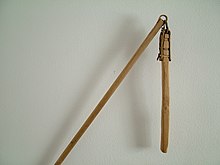Flail


A flail is an agricultural tool used for threshing, the process of separating grains from their husks.
It is usually made from two or more large sticks attached by a short chain; one stick is held and swung, causing the other (the swipple) to strike a pile of grain, loosening the husks. The precise dimensions and shape of flails were determined by generations of farmers to suit the particular grain they were harvesting. For example, flails used by farmers in Quebec to process wheat were generally made from two pieces of wood, the handle being about 1.5 m (4.9 ft) long by 3 cm (1.2 in) in diameter, and the second stick being about 1 m (3.3 ft) long by about 3 cm (1.2 in) in diameter, with a slight taper towards the end. Flails for other grains, such as rice or spelt, would have had different dimensions.

Flails have generally fallen into disuse in many nations because of the availability of technologies such as combine harvesters that require much less manual labour. But in many places, such as Minnesota,[1] wild rice can only be harvested legally using manual means, specifically through the use of a canoe and a flail that is made of smooth, round wood no more than 30 inches long.
Non-agricultural uses
As with most agricultural tools, flails were often used as weapons by farmers who may have lacked better weapons. The flail is proposed as one of the origins of the two-piece baton known in the Okinawan kobudō weapon system as the nunchaku. The first known use of a flail as a weapon was by farmers under the leadership of Jan Žižka during the Hussite Wars in Bohemia.
In ancient Egypt the flail was a symbol associated with the emperor, symbolizing his ability to provide for the people. [2]
References
- ^ "Wild Rice Regulations". Minnesota Department of Natural Resources. Retrieved 6 September 2013.
- ^ http://www.penn.museum/documents/education/pennmuseum_egypt_previsit_combined.pdf
External links
 Media related to Threshing flails at Wikimedia Commons
Media related to Threshing flails at Wikimedia Commons The dictionary definition of Flail at Wiktionary
The dictionary definition of Flail at Wiktionary- Antique Farm Tools
- Agriculture in Victorian Times
- Picture of one kind of rice flail
